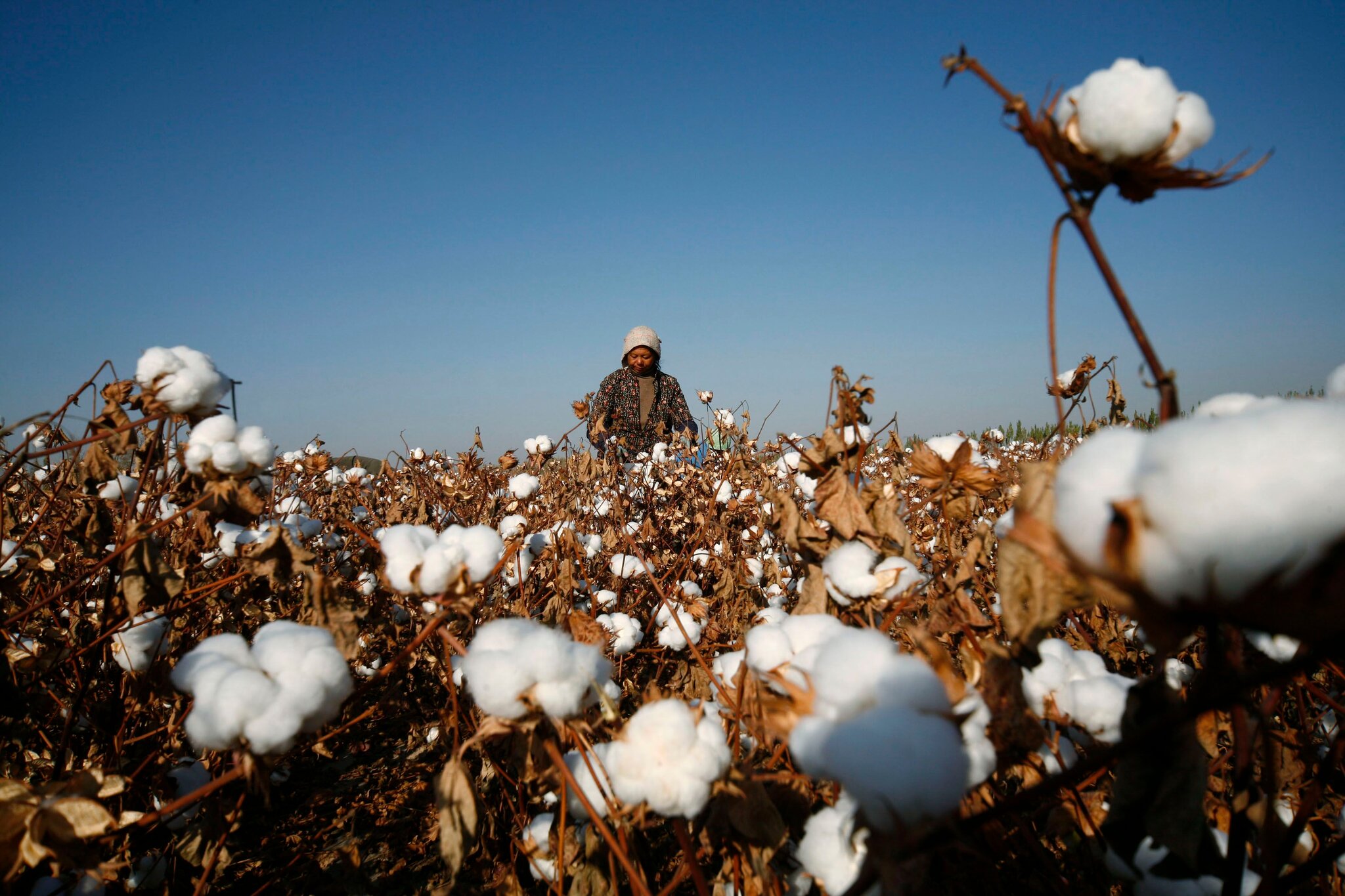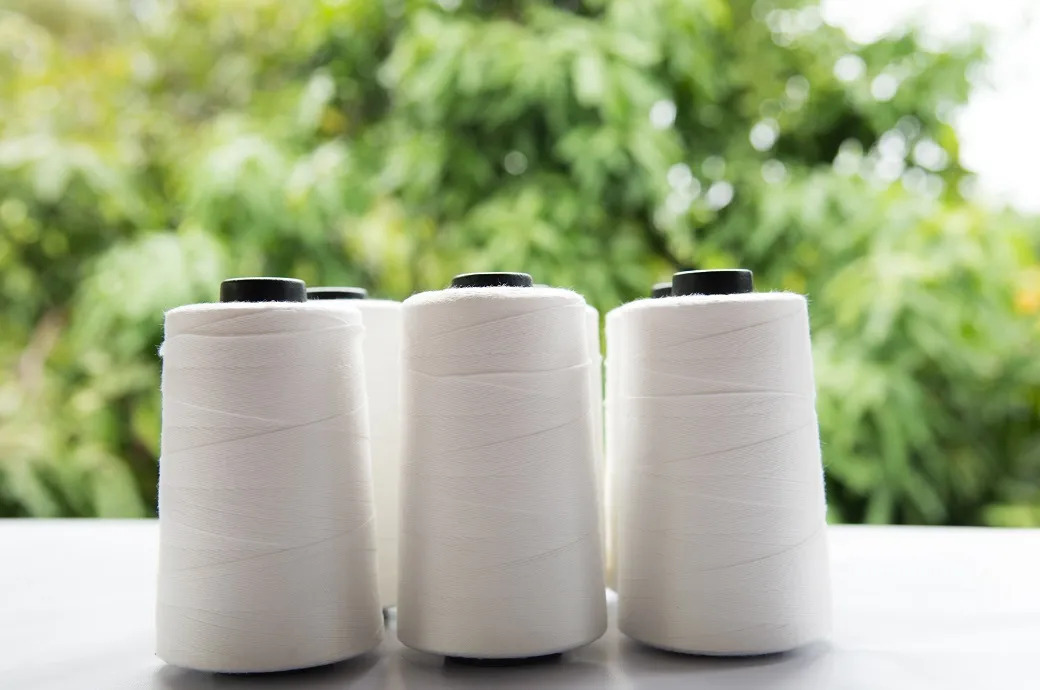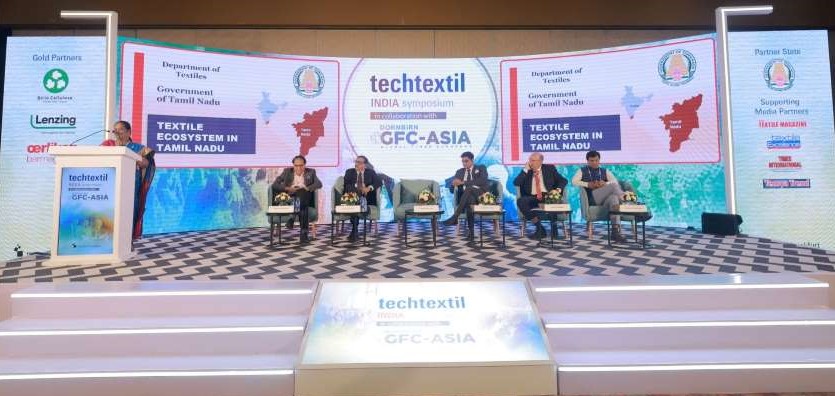FW
The inaugural edition of the bilateral Bangladesh-China Green Textile Expo 2025 (BCGTX) is scheduled to be held from October 23–25 at the International Convention City Bashundhara (ICCB) in Dhaka.
A joint venture between Savor International and the Chinese Enterprises Association in Bangladesh (CEAB), the event will have Bangladesh Garment Manufacturers and Exporters Association (BGMEA) as the Knowledge Partner.
Focusing on Man-Made Fibers (MMF), the exhibition will emphasize innovation, sustainable manufacturing practices, and opportunities for greener production within the textile industry. BCGTX is also teaming up with global initiatives, such as Shanghai Climate Week, to underscore Asia’s position and China’s actions on climate change.
Distinguished professors and experts are scheduled to participate in seminars and sessions, where they will share insights to support sustainable textile development.
The event marks a significant milestone in the more than 50-year diplomatic relationship between Bangladesh and China, aiming to further strengthen cooperation and open new avenues for growth.
European Committee of Textile Machinery Manufacturers, Cematex is significantly expanding its influence and commitment to the future of the EU textile machinery industry. Officially registered in the EU Transparency Register, the organization is boosting its engagement with European Union institutions and stakeholders. As a part of its reinforced presence, Cematex is actively participating in the EU Sustainable Textiles Transition Pathway, pledging support for a greener European textile ecosystem. The group has also joined the EU Textiles Ecosystem platform to ensure stronger connections within the broader EU textiles community.
In response to the evolving legislative landscape, Cematex is closely monitoring key EU initiatives that will shape the upcoming EU textile strategy. These include the Eco-Design Regulation (Textile Delegated Act), the implementation of the Waste Framework Directive across member states, the development of the Product Environmental Footprint Category Rules for apparel, and reforms to market surveillance and customs.
A major focus for Cematex is trade advocacy, particularly addressing hurdles in major markets. The organization is actively challenging the Indian Omnibus Technical Regulation, which mandates compulsory certification by the Bureau of Indian Standards (BIS) for weaving and embroidery machines.
The organization has also submitted a position paper to the Indian Ministry of Heavy Industries and is lobbying for a postponement of the regulation. Simultaneously, it is pushing the European Commission to secure tariff-free access for EU textile machinery exports to India.
On the European front, Cematex has coordinated with industry allies (CECIMO, Orgalim, and CECE) to press the European Commission to classify India's compulsory certification as a Technical Barrier to Trade (TBT) at the WTO, calling for its removal.
The organization is also strengthening its efforts in market surveillance against non-compliant imports. It has developed a position paper for all 27 EU Member State Market Surveillance Authorities (MSAs) and is creating documentation to help identify likely sources of non-compliance.
Furthermore, a new Machine Safety Committee is being established to collect evidence and develop awareness materials for MSAs, customs officers, and even customer associations regarding the risks of non-compliant imported machinery.
Alex Zucchi, President, Cematex notes, his comprehensive engagement is vital to ensure a competitive, sustainable, and innovative future for the European textile machinery industry.
Tonello will launch its new sustainable luxury denim collection, ‘Denim Renaissance: A Journey Into Italian Luxury’ at Kingpins New York on January 22-23, 2026. This new collection reimagines denim as a vibrant medium for self-expression, blending intricate embellishments, sumptuous textures, and opulent gold accents as a direct tribute to Italy's rich and enduring creative heritage.
More than just a fashion statement, Denim Renaissance is a commitment to a thoughtful, conscious future. Tonello showcases how artistry and environmental care can exist seamlessly through the use of innovative and responsible technologies.
Inspired by the boundless beauty and cultural richness of Italy, the collection seeks to redefine luxury. It achieves this through a captivating interplay of curiosity, innovation, and timeless Italian craftsmanship. Every detail is designed to tell a story, with textures exuding sophistication and gold accents capturing the enigmatic allure of Italian artistry.
Ultimately, ‘Denim Renaissance’ represents a place where tradition meets the future, demonstrating how heritage techniques can intertwine with groundbreaking responsible innovations. It invites attendees to experience a world where style is not only beautiful but deeply thoughtful.
A crucial international platform, The Taipei Innovative Textile Application Show (TITAS) emphasizes Taiwan's advanced capabilities in performance and sustainable textiles. According to Justine Huang, President, Taiwan External Trade Development Council (TAITRA), the show connects Taiwan's industry with global partners, including the rapidly growing Indian market.
For over two decades, TITAS has been a beacon of textile innovation. Over the last three years, its focus has increasingly centered on high-performance and sustainable solutions. This shift reflects Taiwan’s direct response to global demands for more functional and eco-friendly fabrics, a trend driven by the urgent need to address climate change.
This transformation into a hub for sustainable solutions underscores Taiwan’s commitment to tackling environmental challenges through technological breakthroughs. By consistently attracting major international brands and retailers, TITAS functions as a critical junction for business opportunities worldwide.
Taiwan’s textile industry is highly export-oriented, necessitating a constant push into global markets. The industry boasts a fully integrated value chain, spanning from raw materials (upstream) to manufacturing (midstream) and finished products (downstream), notes Huang. This comprehensive structure allows Taiwanese firms to offer innovative products and end-to-end services to their international clientele, he adds.
To maintain its competitive edge as a leading global supplier of high-quality textiles, Taiwanese companies have aggressively invested in research and development (R&D). This strategic commitment to innovation ensures the industry not only drives its own growth but also remains aligned with global trends demanding advanced functionality and robust sustainability in textiles.
At an outreach program focused on strengthening trade ties with the United Kingdom, Ajay Bhadoo, Director General of Foreign Trade (DGFT) and Additional Secretary, Ministry of Commerce and Industry urged Micro, Small, and Medium Enterprises (MSMEs) to seek out new global markets and deepen their integration into international supply chains.
Titled 'Gateway to Growth: Harnessing Opportunities under India–UK CETA', the event brought together government officials, diplomats, and major Export Promotion Councils (EPCs) to discuss the transformative potential of the impending Comprehensive Economic and Trade Agreement (CETA).
Anna Shotbolt, Deputy Trade Commissioner for South Asia, British High Commission, hailed the CETA as a milestone and advised Indian exporters to prioritize sustainability and quality compliance to successfully enter the UK’s premium market segments.
Abhishek Dev, Chairman, APEDA, informed, the agri-food sector sees the CETA as a gateway to niche UK categories, including organic produce, ethnic foods, and ready-to-eat products, according to APEDA Chairman Abhishek Dev.
The Gems & Jewelry sector is focused on positioning luxury Indian items in the UK retail landscape. Handicrafts and Carpets are expected to secure niche spaces in the premium UK market while Engineering Goods and Auto Components have strong potential, with success hinging on innovation and strict compliance, he added.
Shotbolt further opined, the Apparel and Textiles sector can boost exports significantly by aligning with ethical and sustainable sourcing standards, a growing requirement for UK buyers.
Ultimately, organizations like the Federation of Indian Export Organizations (FIEO) urged exporters to look beyond traditional markets, embrace digital tools, and leverage the multi-sector opportunities that the CETA is expected to unlock.
Jonathan Anderson, Creative Director, Dior launched his new women’s ready-to-wear collection at the Paris Fashion Week. Having joined the LVMH-owned label in March and showed his menswear collection in June, Anderson is part of a new guard aiming to reinvigorate the luxury industry amidst a prolonged slowdown.
Anderson showcased the iconic Bar Jacket. Famous for its cinched waist, Anderson’s version was loosened, featuring added volume at the back and paired with a pleated mini skirt that also dramatically jutted out.
This look established the foundation for ‘a bold new chapter’ at Dior, according to Simon Longland, Director – Buying, Harrods. He described the collection as one built on contrasts: ‘couture against everyday ease, femininity with androgyny, covered versus sheer.’
Held in the Tuileries Gardens, the show opened with a fast-paced, black-and-white film styled like a horror movie, flashing images from the label’s history. Models then took to the runway, showcasing a range of looks including mini skirts with long wool capes, suit jackets with high collars, dresses with open backs, lightweight knit ensembles and jeans styled either slim or with an ample, barrel-legged silhouette.
The impressive guest list included K-pop sensations Jimin and Jisoo, alongside actors Jennifer Lawrence, Johnny Depp, Jenna Ortega, and Mickey Madison. The audience responded with a standing ovation as Anderson quickly took his bow following the finale.
At the 74th Annual General Body Meeting of the Mumbai unit of the Textile Association (India) [TAI], Rajiv Ranjan was unanimously reelected as the President for the 2025-26 to 2028-29 term. RR Patil was also elected as the new Vice President.
A highly regarded senior professional and strategic business leader with over 40 years of extensive, cross-functional experience in the Indian textile industry, Ranjan has been responsible for managing the Profit & Loss (P & L) for major businesses and demonstrating competence in leadership roles such as Executive Director & CEO, Hindoostan Mills (Thackersey Group), Mumbai and President-Textiles, Mafatlal Industries, Mumbai.
"In these roles, he successfully spearheaded leadership, business, and people transformation. He has a proven track record of setting up Greenfield projects and turning around operations to scale them into sustainable and profitable ventures.
Besides, the TAI Mumbai Unit also appointed the following individuals to other leadership positions. C Bose was appointed as the President Emeritus while VC Gupte was elected as the Chairman. GS Nagirer and VA Bhajekar were elected as Vice-Chairmen. Haresh B Parekh was elected as the Hon Secretary while Navin P Agrawal and Rajendra Ranadive were both named as Joint Honorary Secretaries. Prof KD Gawant was named as the Honoray Treasurer.
"
The three-day, third edition of the Ecosystex conference highlighted a sharp paradox in the continent’s sustainability efforts: a wealth of cutting-edge research is running into a rapidly shrinking industrial base.
Co-organized by the Textile ETP and RISE Research Institutes of Sweden, the Ecosystex conference attracted 160 participants from over 20 countries. The event showcased a promising pipeline of EU-funded projects with an investment nearing €400 million, focusing on innovations like complex textile recycling and pilot materials such as hemp and lignin.
Despite the enthusiasm for scientific progress, a major concern surfaced: Is Europe genuinely on track to industrialize this research, or are these efforts ‘just building castles in the air?’
A subsequent visit to the innovation hub at Science Park Borås underscored the core challenge. While the knowledge base is strong, the industrial landscape presents formidable obstacles. Weak end markets, particularly in fashion and automotive, are forcing companies to cut costs, scale back innovation, or shut down entirely. This creates a critical disconnect: the factories closing in 2025 will not exist to implement new technologies when long-awaited regulations like the Ecodesign for Sustainable Products Regulation (ESPR) and Extended Producer Responsibility (EPR) finally take effect.
The ‘promised land’ of smart regulation remains a waiting game. Although the separate collection of post-consumer textile waste is increasing, viable recycling use cases are lagging. Meanwhile, the rapid growth of ultra-fast fashion continues unchecked, seemingly oblivious to the EU's ambitions to curb its environmental impact.
This situation poses a serious problem for the next generation of talent. Bright, young researchers are being trained in sustainable textile practices but may struggle to find industrial pathways to apply their skills within Europe.
The question now shifts to policy. The industry is anxiously waiting to see if the anticipated EU Clean Industrial Deal or the upcoming Circular Economy Act will provide the necessary support and incentives to ensure Europe becomes a leader, not just a spectator, in the circular textile future. While hope remains for the research, a deep anxiety about Europe's industrial capacity to bring it to life persists.
The European Union has published a revised Waste Framework Directive, kicking off a new era for sustainable textiles. The directive sets a firm timeline for Member States to implement Extended Producer Responsibility (EPR), a policy that requires businesses to take financial and operational responsibility for their products at the end of their life.
The new rules create a 20-month deadline for EU Member States to transpose EPR into their national laws. This means each country must establish a clear framework for how apparel and textile companies will finance and manage the collection and treatment of garments once they're no longer usable. Following this, Producer Responsibility Organizations (PROs) must be fully operational within 30 months. These organizations, funded by producers, will be key to managing the collective obligations under the EPR, including setting up collection systems, ensuring materials are recycled properly, and reporting compliance to authorities.
The European Apparel and Textile Confederation (EURATEX) has welcomed the directive but stressed the urgent need for a unified approach across the EU. The organization has long advocated for a single market for secondary raw materials and the harmonization of EPR schemes to prevent a fragmented, "patchwork" of national regulations. According to EURATEX, a harmonized framework is crucial for supporting competitiveness and innovation within Europe's textile industry.
EURATEX has outlined its key priorities to ensure the directive’s successful implementation, which include ensuring strong market surveillance and coherence with other related legislation, such as the Circular Economy Action Plan (CEA) and Ecodesign for Sustainable Products Regulation (ESPR).
Looking ahead, EURATEX is set to discuss these developments further with its members at the upcoming Textile PRO Forum plenary meeting in November, reinforcing its commitment to a fair, effective, and harmonized framework that benefits both the environment and the European textile sector.
Kohl's is growing its exclusive brands portfolio by launching the FLX apparel range for kids. This activewear and athleisure collection for children and pre-teens combines comfort, function, and style at a great value.
Offering versatility and performance, the new collection features a modern palette of elevated neutrals, wearable everyday silhouettes, and must-have styles like joggers, zip-ups, hoodies, and performance tees that are built for movement and designed to last.
Fit-tested with real movement and self-expression in mind, the new kids' collection balances a modern aesthetic with the functional details today's families expect. With prices ranging from $14.99 up to $50, and sizes running from boys' 8-20 and girls' 7-16, the assortment is designed to keep pace with growth spurts, style shifts, and parents’ budgets.
Nick Jones, Chief Merchandising Officer, Kohl, says, the collection underscores the brand’s continued work to elevate proprietary brands that deliver trusted quality, relevant style, and incredible value for Kohl’s customers."
The FLX apparel for kids serves as a natural transition between children’s styles and adult shapes, offering older kids an opportunity to express their evolving personal style through wearable, playful designs focused on comfort, movement, and fun.
Emmy Jean Woodhall, Creative Design Director, Kohl’s, avers, the brand is ware of how style evolves rapidly, especially for kids entering their tween years. This age group is forming identity and gravitating toward looks that feel more grown-up, but is still playful. The FLX apparel collection for kids reflects this shift with adjusting silhouettes, proportions, and colorways.
The apparel pieces in this collection are made from soft, breathable materials, a focus on fit, and an age-appropriate aesthetic that meets the needs of both parents and kids. With new styles set to be introduced each season, the collection will continue to evolve, giving parents more options as their kids grow and their needs change.
The launch of the new kids' collection marks the next chapter for FLX, a customer-loved brand that debuted in 2021 and has become a standout in Kohl’s proprietary brand offerings. By expanding FLX, Kohl's is reaching more customers and reinforcing its commitment to style, comfort, and value for every generation. This addition to Kohl’s broader brand portfolio - which includes an assortment of exclusive private labels and trusted national names - helps the retailer deliver a well-rounded, accessible selection that meets the evolving needs of today’s families.












